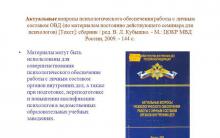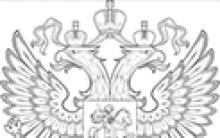The student must:
Know
Indicators characterizing the turnover of working capital;
be able to:
Calculate working capital turnover indicators.
Guidelines
To analyze the use of working capital, assess the financial condition of the enterprise and develop a plan of organizational and technical measures to accelerate their turnover and reduce the duration of one turnover, indicators are used that reflect the real process of movement of working capital and the amount of their release.
The estimated need for working capital is directly proportional to the volume of production and inversely proportional to the speed of their circulation (the number of revolutions). The higher the number of turnover of working capital, the less the need for working capital.
The turnover of working capital and the efficiency of their use are characterized by the following indicators:
Turnover ratio working capital shows the number of revolutions made by working capital during the period of time under consideration:
Revolutions or  , revolutions
, revolutions
The turnover ratio also characterizes return on working capital and shows what volume of output (in prices or at cost) is provided by one ruble of working capital. The higher the value of the working capital turnover ratio, the more efficiently the working capital of the enterprise is used in the period under review, the higher the return on each ruble invested in working capital.
The time during which working capital completes the circuit, i.e., passes through the production period and the circulation period, is called the period, or the duration of the turnover of working capital. This indicator characterizes average speed of funds movement at the enterprise. It does not coincide with the actual period of production and sale of certain types of products. Duration of one revolution in days (Add) determined by the formula:
Where OS- balances (availability) of working capital:
averages over a period of time (OSSR) or at the end of the period (OSK), rub.;
Qcomrade; Qreal - volume of commercial or sold products, rub.
Stov - cost of commercial products, rub.;
T - number of days in the reporting period (360 in a year, 90 in a quarter, 30 in a month)
Loading factor (consolidation) of working capital (Kz) -- an indicator that is the inverse of the turnover ratio. It characterizes the capital intensity of working capital and shows the amount of working capital that ensures the production of marketable or sold products in the amount of I rubles. (in prices or at cost) and is calculated using the formula:
Rub. OS/RUB
The lower the value of the working capital load factor, the more efficiently the working capital of the enterprise is used in the period under review.
When analyzing the use of working capital, the amount of their absolute and relative release is calculated.
Absolute release working capital. It makes sense to calculate this indicator only when the same volume production according to plan and actually, or with the same volume of production in the reporting and base periods, since when the volume of production changes, the required value (amount) of working capital also changes. Absolute release calculated as the difference between the average balance (availability) of working capital involved in turnover of the subsequent and previous periods
![]() , rub.
, rub.
This indicator can have either a “plus” or a “minus” sign. If Δ OSabs has a minus sign, then there is a release of working capital, and if Δ OSabs has a plus sign, then funds for this amount are additionally involved in circulation.
For example, in practice, absolute release (with a minus sign) occurs when the actual need for working capital in the reporting period is less than planned, provided the same volume of products is produced.
Relative release working capital takes place only when accelerating working capital turnover, i.e. when reducing the duration of the 1st revolution and an increase in the number of turnover of working capital in the subsequent period of time compared to the previous period. In this case, the volume of production may change:
![]() , rub. or
, rub. or ![]()
Rub. or
Qone– one-day production output (in prices or at cost) in the subsequent period (or actual), rub.;
ΔAdd– reduction in the duration of one turnover of working capital in the subsequent period of time compared to the previous period, days.
Minus sign ΔAdd shows that there is a release of working capital.
If Q0 = Q1 or Qpl= Qf, then the value Δ OCotn=Δ OSabs
Methods for assessing material and production
Inventories
When releasing inventories for production or otherwise disposing of them, they can be assessed in accordance with one of the methods:
· FIFO method;
· LIFO method;
· at average cost;
· at the cost of each unit.
The choice of a specific method depends mainly on what problems the organization solves in the field of finance, investment and taxation.
Method FIFO assumes that materials should be written off at cost of the relevant batches in the chronological order of their receipt. In conditions of inflation, it causes an underestimation of the cost of resources released into production, an overestimation of their balance in the balance sheet, and, consequently, an overestimation of the financial result from core activities and an improvement in liquidity indicators. The FIFO method is advisable to use for organizations planning to make capital investments at their own expense and enjoying the corresponding income tax benefits.
Method LIFO assumes priority write-off of materials at the cost of the latest batches. This method ensures an overestimation of the value of sold valuables, an underestimation of their balance at the end of the month, which means a decrease in profits and a deterioration in liquidity. It is recommended for use by those organizations that have the goal of minimizing income tax.
Method average cost makes it possible to evaluate supplied resources at the average purchase cost. It is moderate in terms of impact on profit and liquidity compared to the methods discussed above.
Method cost of each unit based on an individual assessment of material reserves. This applies primarily to inventories used by the organization in a special manner (precious metals, precious stones, etc.) and inventories that cannot be replaced in the usual way. The possibility of using this method has been officially provided since 1999.
These methods can be used in organizations subject to three restrictions:
1) the chosen method is fixed in the accounting policy and is valid throughout the reporting year;
2) the method must be uniform for the type (group) of materials;
3) do not fall under established exceptions, namely, materials that cannot replace each other. There is only one valuation method for them - at the cost of each unit.
Indicators of the use of working capital.
Working capital of enterprises is in constant motion, making a circuit that has 3 stages:
Stage I - This is the preparation of objects of labor. At this stage, working capital received by the enterprise in the form of money is spent by it on the acquisition of inventory.
Stage II The circulation flows in the sphere of production - material assets enter production and finished products are created.
Stage III – sales of finished products. This stage ends with the receipt of funds for sold products. Working capital returns to its original form and begins the circuit again.
D – PZ … P … GP – D′
The successive change of monetary, production and commodity forms of working capital is called turnover of working capital .
The turnover of working capital largely determines the efficiency of their use by the enterprise. Turnover O.S. can be characterized as follows indicators :
1) Number of revolutions for a certain period, or turnover ratio working capital (K o), calculated by the formula
K o = R p / C o,
where K about is the turnover ratio of working capital, turnover
R p - volume of products sold over a period of time, rub.;
C o - average amount of working capital for the same period, rub.
Co for a period, for example a quarter, is determined by the formula
(0.5 * Cob1 + Cob2 + Cob3 + Cob4*0.5) / 4
The turnover ratio characterizes the number of turnovers made by the working capital of an enterprise for a certain period, or shows the volume of products sold per 1 ruble. working capital. An increase in the number of revolutions leads either to an increase in output by 1 ruble. working capital, or to the fact that a smaller amount of working capital needs to be spent on the same volume of production.
2) Load factor working capital – an indicator inverse to the turnover ratio. It characterizes the amount of working capital spent per 1 ruble. products sold:
Kz = Co/ R p,
where Kz is the working capital load factor.
3) Duration of one revolution working capital is found by dividing the number of days in the period by the turnover ratio:
D o = D k / K o,
where D k is the calendar number of days in the period (360; 90; 30).
The faster one circulation of working capital is completed with the same volume of products sold, the less working capital is required, the more efficiently they are used.
The effect of accelerating the turnover of working capital is expressed in the release and reduction of the need for them due to improved use.
A distinction is made between absolute and relative release of working capital.
Absolute release reflects a direct decrease in the need for working capital while maintaining the sales volume for the period under review.
Relative release occurs when the growth rate of production volumes exceeds the growth rate of working capital. In this case, a smaller amount of working capital ensures a larger sales volume.
Example:
Absolute release occurs when in the year under review the amount of working capital is less than in the previous one and is determined by the formula:
∆Cab abs = Cb 0 – Cb 1, Where
Et 0 and Et 1 respectively, the actual amount of working capital in the previous and year under review.
Relative release working capital means that in a given year the company completed a larger volume of work with a smaller amount of working capital. The relative release of working capital as a result of accelerated turnover compared to the previous year is calculated using the formula:
, Where
Tob 0– the duration of one revolution in the previous year;
Qreal 1 – volume of products sold in the year under review;
Event 1 – the average amount of working capital in the year under review;
360 – the duration of the year under consideration.
OSotn = RPpl / Co pr.g. - RPpl / Ko pl
RP – volume of products sold in the planning period
Ko - return coefficients, respectively, in the previous period and the planning period
For example:
Qreal 0 = 100 million rubles.
Qreal 1 = 120 million rubles. Tr Qreal = 120/100 = 120%
Total 0 = 16.7 million rubles.
Sob 1 = 18 million rubles. Tr Sob = 18/16.7 = 107.8
Define absolute and relative release (overexpenditure) of working capital
∆Cab abs = 16.7 – 18 = -1.3 million rubles (overexpenditure)
Let's calculate ∆Cob rel.
We determine Tob 0 = 360/N 0 = 360 Sob 0 /Qreal 0 = 360*16,700,000/100,000,000 = 60 days.
360/N 1 = 360*18,000,000/120,000,000 = 54 days.
∆Tob = 60 – 54 = 6 days.
If the turnover rate in the year under review were the same as in the past, then the following working capital would be required:
Sob′′ = Tob 0 Qreal 1 /360 = 60*120,000,000/360 =20 million rubles.
Therefore, ∆Sob rel = Sob′′ – Sob 1 = 20 million – 18 million = 2 million rubles.
The relative release of working capital in the year under review as a result of accelerated turnover amounted to 2 million rubles.
That. if you speed up the process of working capital passing through all 3 stages, i.e. speed up the turnover of working capital, then you can either complete a larger volume of work or the same volume, but with lower costs of working capital, in the same time.
Therefore, accelerating the turnover of working capital leads to a decrease in the need for them and serves as one of the indicators of the efficiency of the production and economic activities of the enterprise.
Today, issues of saving material resources and reducing production inventories, issues of maximum involvement of secondary raw materials in economic circulation have become very relevant.
According to economists, more than 5 billion tons of waste accumulates in the country every year. With current technologies, such a number of them is inevitable! For example, in the old peasant farm there was no waste, everything went into use. There was a closed natural-economic cycle, even the ash remaining in the stove after burning wood was used as fertilizer, not to mention manure. The natural connections between nature and the economy were disrupted with the advent of industry. Unfortunately, while creating a socialist society, we adopted cheap “nature-destroying technologies.” But the bureaucratic, administrative nature of economic management forced us to follow the old path. Most developed countries have already switched to intensive development methods, which involve increasing results at the same or lower costs.
To produce the same volume of products, we spend 1.5–2 times more raw materials, materials, fuel, and energy than in developed countries.
Accelerating the turnover of working capital is the primary task of enterprises in modern conditions and is achieved in the following ways:
Strict control over the use of available working resources;
Rational organization of industrial reserves (their economical use; liquidation of excess reserves; improvement of rationing and the material and technical supply system);
Timely execution of documentation; compliance with payment and contractual discipline
Related information.
Release of working capital
Rationing of working capital
Duration of one revolution
Working capital indicators
1 . Turnover ratio shows how many times during a month or year a product is converted into money.
where K rev is the turnover ratio
R p - volume of products sold, UAH.
О с - balance of working capital, UAH.
2 . Working capital consolidation ratio - the inverse indicator of the turnover ratio, which characterizes the amount of working capital spent on 1 UAH. sold products.
where K 3 is the fastening coefficient
where T is the duration of one revolution, days
D - number of days in the period (360, 180, 90)
where N ob.s - rationing of working capital
N pr.z - rationing of inventories
N refinery - refinery rationing
N ᴦ.п - rationing of finished product inventories
where Z current. - current stock of materials, UAH.
3 pages - safety stock of materials, UAH.
3 tr. - transport stock of materials, UAH.
where Ps is the daily need for materials, UAH.
T p - period between two next deliveries of this type of material, days
where T is the number of days in the period (360, 90, 60,)
Q - need for raw materials, UAH
Q= N consumption* N
where N expense _ standard cost per part, UAH.
N - number of products, pcs.
where T is the average delay time for the next delivery of this type
material, days
where T z - transport stock, days
Q basic + Q aux. + Z norm. + O f + d
where Q main. - material requirements for main production
Q aux. - material requirements for auxiliary production
Z nor - standard reserves of material
Of - actual material balances at the beginning of the planned
d- use of internal reserves (waste recycling, scrap)
The faster circulating assets circulate, the more efficiently they are used.
The effect of accelerating the turnover of working capital is expressed in release, reducing the need for them due to improved use.
Absolute release- reflects a direct decrease in the need for working capital. (120-20 = 100 thousand UAH)
Relative release- reflects both the change in the amount of working capital and the change in the volume of products sold. To determine it, you need to calculate the need for working capital for the reporting year based on the actual turnover of product sales for a given period and turnover in days for the previous year. The difference gives the amount of release.
Eg: = 120,000 thousand UAH.
110500 thousand UAH,
72, - 65 days.
The need for working capital at a turnover of 1995ᴦ. and sales volume 1995 ᴦ. will be equal to: (612000 * 72) : 360 = 122400 thousand UAH. Relative release 122400 - 110500 = 11900 thousand UAH.
Topic: Intangible resources and assets
1. Understanding and types of intangible resources
2.Understanding the classification of intangible assets
Intangible resources- part of the potential of an enterprise that can bring economic benefits for a long time, which is characterized by the lack of a material basis and the uncertainty of the size of future profits from its use. |
The concept of “intangible resources” is used to characterize a set of intellectual property objects, which include:
1) objects of industrial property;
3) other (non-traditional) objects of intellectual property.
| Objects that are protected by copyright |
Intellectual property is a legal category that is used for:
1) determining the results of a person’s creative work;
2) designation of the ownership of such results by the relevant subjects of creative activity;
3) assigning to these entities personal non-property and property rights to the development and use of intellectual products created by them.
Intellectual Property Rights- is the right of a person to the result of intellectual activity or to another object of intellectual property rights.
Objects of industrial property include:
Invention- this is the result of human creative activity in the field of technology, the solution of technical specifications in a certain sector of the national economy, is characterized by significant novelty and provides a positive effect (practical usefulness).
Opening- ϶ᴛᴏ establishment of previously unknown phenomena or patterns in the material world.
Rationalization proposal- ϶ᴛᴏ solving a technical problem that is relatively new and has a positive effect
Utility model- this is the result of human intellectual activity, the object of which is a new type, shape, arrangement of parts or construction of a model, suitable for industrial production.
Industrial designs- a new artistic and artistic design solution for products, when the unity of technical and aesthetic properties is achieved, which determine the appearance of an industrial product.
An industrial design can be three-dimensional (model), flat (drawing) or combined.
Trademarks (marks for goods and services)- any original designation or any combination of designations by which the goods and services of some persons differ from similar goods and services of other persons. The main task of a trademark is to identify a product or service and its manufacturer on the market. It performs two functions simultaneously:
2) guarantees their quality.
Know-how- this is information of any nature (inventions, original technologies, knowledge, skills, etc.) that are protected by a trade secret regime and are the subject of purchase and sale or used to achieve a competitive advantage over other business entities.
trade secret- a confidentiality regime for information that allows its owner, under existing or possible circumstances, to increase income, avoid unjustified expenses, maintain a position in the market for goods, works, services, or obtain other commercial benefits. The information confidentiality regime is usually understood as the introduction and maintenance of special measures to protect information.
2.Intangible assets are one of the types of non-current assets and represent long-term use assets that do not have a material (physical, natural) form.
According to P (C) BU 19 intangible assets- all assets other than cash, cash equivalents and receivables in a fixed (or determined) amount of money.
Classification and accounting of intangible assets is carried out for each object in the following groups:
1) the right to use natural resources(the right to use subsoil, other natural resources, geological and other information about the natural environment, etc.);
2) the right to use property(the right to use a land plot, the right to use a building, the right to rent premises, etc.);
3) rights to marks for goods and services(trademarks, trademarks, trade names, etc.);
4) rights to industrial property objects(right to inventions, utility models, industrial marks, plant varieties, animal breeds, know-how, protection from unfair competition, etc.)
6) goodwill is the excess of the acquisition cost over the buyer's share of the fair value of the identifiable assets and liabilities acquired at the acquisition date. In other words goodwill- is the difference between the market and book value of the enterprise.
Date of purchase- the date on which control of the net assets and activities of the acquiree passes to the buyer.
Positive goodwill means that the value of the enterprise exceeds the total value of its assets and liabilities, and negative indicates that the enterprise is undervalued;
7) Other intangible assets(the right to carry out activities, use economic and other privileges, etc.).
The main features of intangible assets are:
Lack of material structure,
Use for a long time (more than a year),
The ability to be useful to the enterprise;
A high degree of uncertainty in the size of possible future profits due to their use.
Topic: Innovation and investment activities of enterprises
1. Characteristics of innovative and innovative activities
2. Economic essence, classification and structure of investments
Innovation- ϶ᴛᴏ new creation or improvement of the competitiveness of technology, products or services, as well as organizational and technical solutions, production, administrative, commercial, or other nature, significantly improving the structure and quality of production and the social sphere.
The following data is available for the second quarter of 2014 and 2015. by enterprise (thousand rubles):
Define:
1) for each year, working capital turnover indicators and their dynamics (in%);
2) the amount of funds released (or additionally attracted) as a result of acceleration (slowdown) of turnover of working capital. Present the calculation results in table form. Draw conclusions.
Solution:
1) The working capital turnover ratio is determined by dividing the volume of product sales at wholesale prices by the average balance of working capital in the organization:
K o - working capital turnover ratio, volume;
R p - volume of products sold, thousand rubles;
Average balance of working capital, thousand rubles.
Let's find the average balance of working capital.
The dates for which data are available are not equidistant from each other.
The average level for the year in this case is determined as:

t i is the time during which the level was maintained.
Average balance of working capital in 2014:
Working capital turnover ratio in 2014:
![]()
Average working capital balance in 2015:
Working capital turnover ratio in 2015: ![]()
The increase in the working capital turnover ratio is equal to:

Consequently, working capital turnover decreased by 10.9%.
An indicator of the average duration of turnover in days.
Tob) days is found by dividing the number of days in the period by the turnover ratio:![]()
![]()
There was a slowdown in the turnover of working capital.
2) When the turnover of working capital slows down, additional attraction (involvement) of them into circulation occurs. The amount of additional funds raised as a result of a slowdown in the turnover of working capital can be found in one of the following ways:

The calculation results are presented in the table.
| No. | Index | Symbol | 2014 | 2015 |
|---|---|---|---|---|
| 1 | Revenue from sales of products excluding VAT, thousand rubles. | R P | 442,8 | 654,2 |
| 2 | Production growth rate | K r | - | 1,477 |
| 3 | Working capital on average for the year, thousand rubles. | 21,59 | 35,81 | |
| 4 | Turnover ratio, vol. | K o | 20,51 | 18,27 |
| 5 | Duration of one revolution in days | T about | 17,55 | 19,70 |
| 6 | Change in the duration of one turnover of working capital in days | Δ T about | - | 2,15 |
| 7 | Amount of additional funds raised, thousand rubles. | Δ | - | 3,91 |
Conclusion: If turnover slows down, it is necessary to involve additional funds in the amount of 3.91 thousand rubles.
One of the most important indicators of the efficiency of a company's production activities is asset turnover. After all, the faster the values go through the full production cycle, the more efficient the functioning of the enterprise. The release of working capital is the financial result of accelerating the turnover of current assets. Let's look at what current assets are and what role the release of working capital plays.
An organization's valuable assets used in the course of business activities can be classified depending on the degree of liquidity, that is, the ability to quickly convert into cash equivalent, as well as how long the period of use of the asset is. If we are talking about non-current assets, then we cannot talk about them as liquid assets. This category includes machines and equipment, capital buildings, intangible assets and other property with similar characteristics. The use of such assets exceeds one calendar year and is transferred to the cost of production in installments.
Working capital has diametrically opposite characteristics. This category of assets is largely determined by significant liquidity (with the exception of unrealistic receivables and stale inventories of material assets).
Working capital transfers its value to manufactured products in full. The use of this category of property for the most part does not exceed the duration of one production cycle or one calendar year.
What is the amount of released working capital?
In the case when, in the process of conducting business activities, by rationalizing the use of working capital, a reduction in the need for them is achieved, we can talk about the release of working capital (the formula for calculation will be presented below).
The importance of the asset release process for a company cannot be underestimated, since actual savings in material costs are one of the basic sources of cost reduction, increased profitability and real profit levels.
Absolute and relative release of working capital
At its core, in practice there is a relative and absolute release of working capital.
The absolute release of working capital consists of a direct reduction in the organization's need for current assets. This type of cost reduction occurs in cases where asset balances are significantly lower than the standard established by the company, or the amount noted in previous periods.
As for the relative release of working capital (we will consider the formula below), this indicator considers the relationship between a reduction in the amount of working capital of the company and an increase in the amount of marketable products produced by the enterprise. This type of release occurs in cases where the process of accelerating the cycle of current assets is carried out simultaneously with an increase in the number of commercial products produced. At the same time, the rate of production growth should significantly outpace the increase in asset balances.
In order to determine the amount of released working capital, both in absolute and relative terms, it is enough to use mathematical calculation formulas. Let's consider each of them.
The absolute release of working capital - the formula - can be presented as follows:
Absolute release = (Duration of 1 revolution in the base period – Duration of 1 revolution in the reporting period) / Volume of current assets / Period.
In this case, the relative release will be determined using the formula:
Relative release = Volume of current assets in the base period * Growth rate of manufactured products - Volume of current assets in the reporting period.
Thus, determining the release of working capital, both in absolute and relative terms, is not difficult when using the following calculation formulas.
The process of absolute release occurs in cases where the actual need for assets is significantly lower than the planned one. In this case, it will be necessary to compare the real need for assets, relevant for the previous period, and their planned need, provided that production volumes either remain at the current level or increase.
Relative release manifests itself in the form of a reduction in the real value of the company's assets in the period under review in comparison with the results achieved previously.
Let's look at how the amount of released working capital is determined using a practical example.
In the current year, the real V of output was achieved - 1200 tr, while the volume of all current assets amounted to 1500 tr, the planned output for the next year was 2000 tr. provided that asset turnover will be increased by 5 days.
- Let's determine turnover:
O = 1500 / (1200 / 360) = 45 days;
- Amount of working capital:
OS = 20000 * 45 / 360 = 2500 TR;
- The amount of working capital next year:
OS = 2000 * (45 – 5) / 360 = 2220 tr.
- Relative asset release:
OB = 2500 – 2220 = 280 tr.
Calculating the relative and absolute release of current assets using the above formulas allows organizations to speed up the process of turnover of existing assets and identify hidden reserves, which, in turn, will ensure the emergence of free cash resources that the company can direct to business development without involving third parties sources of financing activities.











Regulations on the head of a structural unit on the status of the head of a structural unit
Direct marketing - what is it in examples
Where do poisonous potatoes come from? What to do with poisonous potatoes in Minecraft
He does not allow himself and others to be bullied.
Remuneration model: grades 11 grade in Sberbank